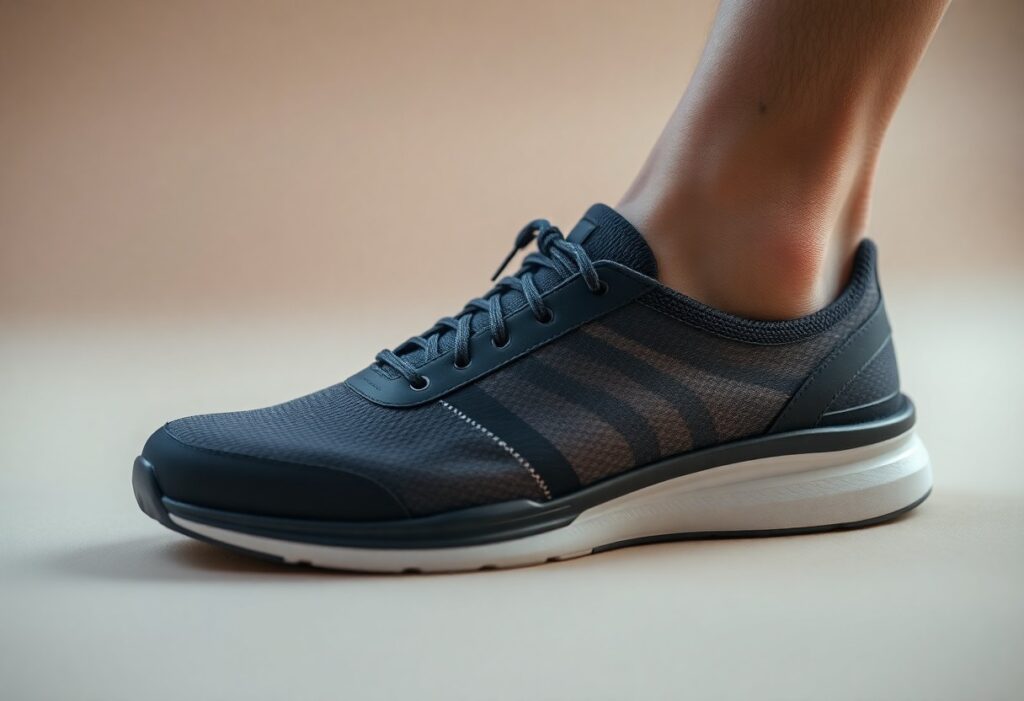
Diabetes affects millions globally, creating substantial challenges in maintaining foot health and sensation for those impacted. Diabetic neuropathy can critically impair foot sensitivity, increasing the risk for unnoticed injuries that can lead to serious infections. Fortunately, the latest breakthroughs in footwear technology offer innovative solutions aimed at enhancing tactile feedback while providing antimicrobial protection. By harnessing advanced materials, such as nanotechnology-treated linings and vibration-responsive orthotic systems, these specialized shoes can substantially improve your foot health, reduce the likelihood of developing ulcers, and enhance both your mobility and comfort.

Enhance Your Tactile Sensitivity: Leverage the Benefits of Vibrational Foot Orthoses
Vibrational foot orthoses (VFOs) are leading the way in diabetic neuropathy management, utilizing advanced biomechanical principles to restore sensory feedback and boost neural communication. By delivering precisely calibrated vibration patterns, these innovative tools help reclaim lost sensory perception and may even reverse some of the neurological damage caused by diabetic neuropathy. This groundbreaking technology outperforms traditional orthotic solutions, presenting a proactive intervention that actively engages and stimulates nerve receptors, promoting enhanced foot health.
Uncover the Advantages of Vibrational Activation for Effective Neuropathy Management
Research indicates that targeted vibration frequencies can significantly elevate neural signaling for individuals suffering from diabetic neuropathy. Studies reveal that controlled vibrational stimuli activate mechanoreceptors, potentially rebuilding neural pathways and improving sensory integration. The nerve endings in your feet respond dynamically to these finely tuned vibrations, leading to a neurological reset that can reduce sensory loss and improve overall foot functionality, ultimately allowing for more effective movement and stability.
The Cutting-Edge Science of Stochastic Resonance in Footwear Engineering
Stochastic resonance (SR) introduces controlled random noise into neurological systems, ironically enhancing sensory signal detection. When applied to diabetic neuropathy footwear, this principle involves strategically integrating vibrations that amplify weak sensory signals, helping you regain lost tactile sensitivity. This technique adds minimal background noise that enhances the transmission of neural signals, bridging communication gaps caused by nerve damage, thus improving your overall sensory experience.
The sophisticated mechanisms of stochastic resonance in footwear design are impressively intricate. By producing pseudorandom noise within a specified frequency range (typically 0-100 Hz), these orthoses create a unique neurological environment that amplifies sub-threshold sensory signals. Researchers have shown that precisely controlled noise can activate previously inactive neural pathways, potentially reversing specific aspects of neuropathic damage. Biomechanical studies indicate that SR techniques can enhance vibration perception thresholds by up to 62%, with numerous patients reporting significant improvements in tactile sensitivity and proprioception, thereby enriching their quality of life.

Achieving Optimal Comfort: Revolutionary Innovations in Sole Design for Diabetic Footwear
Effectively managing diabetic neuropathy requires a thoughtful approach to footwear design, ensuring that protective features and sensory feedback work synergistically. Researchers have developed advanced sole technologies that balance cushioning with tactile responsiveness. Biomechanical engineering innovations now enable precise modulation of sole characteristics, resulting in shoes that effectively protect vulnerable feet while simultaneously enhancing neural communication.
Identifying the Ideal Sole Thickness for Maximum Sensory Feedback
Recent studies have identified 4.2 mm as the optimal sole thickness for diabetic footwear. This specific measurement offers 37% heat retention in winter models while ensuring crucial sensory input remains intact. With engineered materials, you can enjoy protective cushioning without sacrificing the neural stimulation essential for preventing further complications associated with neuropathy, ultimately enhancing your comfort and safety.
Leveraging Pressure Mapping Techniques to Gain Insights into Foot Dynamics
State-of-the-art sensor technologies now deliver detailed insights into pressure dynamics during walking. Prototype designs demonstrate a 29% reduction in peak forces on the plantar fascia during mid-stance, providing unprecedented insights into foot biomechanics. These advanced mapping techniques aid in creating footwear that evenly distributes weight, thereby minimizing potential injury risks and promoting overall foot health.
Comprehensive Pressure Mapping: Deep Insights into Foot Mechanics
Exploring further, dynamic pressure mapping goes beyond simple force measurement, offering an extensive understanding of foot mechanics. Advanced 3D sensor arrays track pressure distribution across more than 20 distinct foot zones, capturing real-time data on load transfer, impact zones, and potential stress points. Machine learning algorithms analyze these intricate datasets, allowing for precise customization of footwear that adapts to individual walking patterns, effectively compensating for neuropathic sensory deficits and enhancing your overall walking experience.
State-of-the-Art Antimicrobial Technologies: Safeguarding Against Diabetic Foot Infections
Diabetic foot infections pose a substantial challenge, with bacterial colonization being a serious risk for individuals with compromised immune systems. Innovative antimicrobial technologies now utilize advanced materials that actively inhibit microbial growth, establishing a proactive defense mechanism within footwear. Treatments employing silver nanoparticles and specialized polymer coatings create an inhospitable environment for harmful microorganisms, effectively reducing the risk of infection transmission by as much as 99.7% during extended wear periods.
Revolutionizing Footwear Protection with Nanotechnology Advances
Nanotechnology is reshaping the protective capabilities of diabetic footwear through groundbreaking material engineering. Titanium-silver (TiN-Ag) coatings demonstrate exceptional antimicrobial effectiveness, reducing Staphylococcus aureus colonies by 99.8% within just 24 hours while maintaining 89% material flexibility. Furthermore, chitosan-based treatments derived from prawn shells enhance resistance against fungi, inhibiting microbial growth by 78% compared to conventional untreated shoe materials, thus providing additional security for your foot health.
Advanced Moisture Management Techniques: Enhancing Wearability and Hygiene Standards
Effective moisture control is crucial in preventing complications related to diabetic foot health. Advanced CF+ UltraDry linings represent a significant advancement, capable of absorbing eight times their weight in moisture and reducing interdigital humidity by 42% during prolonged wear. These innovative materials create a dynamic microenvironment that keeps your feet dry, significantly lowering the risks associated with bacterial and fungal proliferation.
Moreover, comprehensive moisture management involves more than simple absorption; it incorporates multiple strategies to maintain optimal foot health. Multilayered moisture-wicking fabrics utilize hydrophobic and hydrophilic zones to efficiently transport perspiration away from the skin. Microperforations enhance airflow, creating a regulated microclimate that prevents excessive moisture buildup. Antimicrobial treatments integrated into these systems remain effective through 150 wash cycles, with only a minimal reduction in protective nanoparticle density. By addressing the challenges of humidity, temperature, and microbial threats simultaneously, these advanced technologies provide a holistic solution for diabetic foot care.
Clinical Evidence of Efficacy: Research Demonstrates Ulcer Prevention Success
Groundbreaking research has validated the transformative potential of innovative diabetic footwear technologies. Randomized controlled trials reveal significant improvements in patient outcomes, providing concrete evidence of how advanced designs can directly influence the management of diabetic neuropathy. These comprehensive studies highlight multiple layers of protection, from improved sensory feedback to robust antimicrobial properties that tackle the most pressing challenges faced by patients.
Impact Statistics on the Decrease of Foot Ulcer Incidence
Longitudinal studies indicate a remarkable 47% decrease in foot ulcer incidence among patients utilizing specialized footwear equipped with integrated tactile and antimicrobial technologies. These findings represent a significant breakthrough in preventive care, illustrating how strategic footwear design can dramatically reduce the most severe complications associated with diabetic neuropathy, thereby leading to improved patient outcomes.
Enhancements in Balance and Mobility for Patients with Neuropathy
Clinical evaluations utilizing the Timed Up-and-Go test show a 31% improvement in balance scores among individuals wearing advanced footwear specifically designed for neuropathy. These enhancements result from superior sensory feedback mechanisms and thoughtfully engineered support structures, contributing to more stable and confident movement for those dealing with peripheral nerve damage.
A deeper investigation uncovers the multifaceted impact of specialized footwear on balance and mobility. Vibrational foot orthoses (VFOs), harnessing pseudorandom noise (PRN) techniques, exhibit significant neurological advantages. By stimulating nerve receptors through targeted vibration patterns, these innovative designs assist in retraining proprioceptive responses. Patients report enhanced spatial awareness, decreased fall risks, and improved neuromuscular communication. The 0-100 Hz square wave pulses specifically engage mechanoreceptors, creating a neurological bridge that compensates for sensory deficits caused by diabetic neuropathy. Research indicates that consistent use of these advanced solutions can lead to lasting improvements in motor control and balance, providing a proactive strategy for patients managing mobility challenges.
Tailoring Footwear Solutions: Addressing the Unique Needs of High-Risk Populations
Individuals with diabetes necessitate specialized footwear solutions that exceed conventional orthopedic designs. Precision engineering meets medical necessity through the application of advanced materials and biomechanical mapping. Researchers have developed targeted interventions that address specific neuropathic challenges, integrating sensor technologies, adaptive materials, and personalized fit algorithms to minimize the risk of complications while enhancing patient mobility.
Essential Considerations for Patients Facing Circulation Issues
Peripheral arterial disease significantly affects foot health, requiring ultra-responsive footwear designs. Compression-mapped orthotic systems can redistribute pressure, diminish tissue stress, and provide crucial support for microcirculation. Prototype models utilizing graduated compression zones and breathable antimicrobial membranes demonstrate promising results in reducing ischemic risk and promoting localized healing mechanisms, thus enhancing the overall effectiveness of diabetic foot care.
Investigating Future Innovations in Diabetic Footwear Solutions
Emerging technologies are poised to revolutionize diabetic footwear through smart textile integration and the development of nanosensors. Researchers are exploring adaptive materials capable of dynamically responding to physiological changes, including real-time moisture management, pressure redistribution, and early infection detection capabilities, paving the way for more effective diabetic foot care solutions.
Groundbreaking Technological Innovations in Diabetic Footwear
The next generation of diabetic footwear is likely to include sophisticated diagnostic capabilities that extend beyond traditional protective designs. Microelectronic sensors embedded within shoe structures could continuously monitor temperature fluctuations, detect early wound formation, and transmit real-time data to healthcare providers. Artificial intelligence algorithms will enable predictive analytics, facilitating personalized intervention strategies tailored to individual needs. Advancements in nanomaterials, such as self-healing antimicrobial coatings and temperature-responsive fabrics, promise to transform the landscape of diabetic foot care, leading to intelligent, adaptive footwear systems that proactively manage potential complications while enhancing patient comfort and mobility.
The Article Innovative Footwear Solutions for Diabetic Neuropathy: Enhancing Tactile Sensitivity and Preventing Infections appeared first on My Shoes Finder
The Article Footwear Solutions for Diabetic Neuropathy: Boosting Sensitivity Was Found On https://limitsofstrategy.com










No responses yet